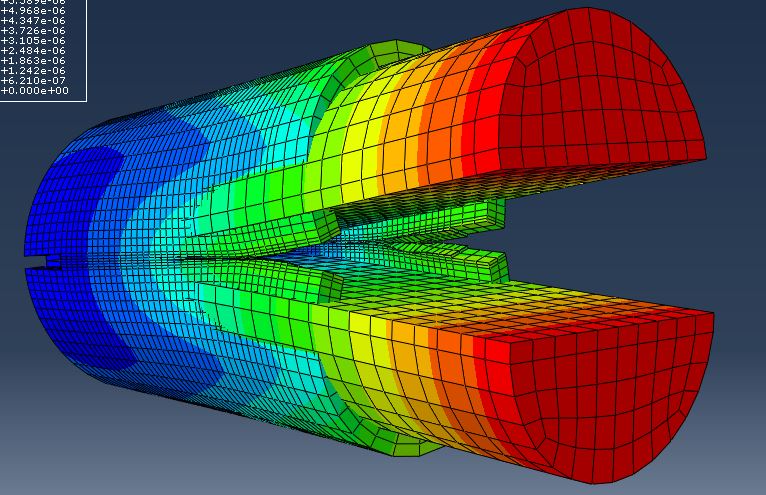SIMULIA Abaqus 2023

Product simulation is often performed today by engineering groups using niche simulation tools from different vendors to simulate various design attributes. The use of multiple vendor software products creates inefficiencies and increases costs. SIMULIA delivers a scalable suite of unified analysis products that allow all users, regardless of their simulation expertise or domain focus, to collaborate and seamlessly share simulation data and approved methods without loss of information fidelity.
The Abaqus Unified FEA product suite offers powerful and complete solutions for both routine and sophisticated engineering problems covering a vast spectrum of industrial applications. For example, in the automotive industry engineering work groups can consider full vehicle loads, dynamic vibration, multibody systems, impact/crash, nonlinear static, thermal coupling, and acoustic-structural coupling using a common model data structure and integrated solver technology. Best-in-class companies are taking advantage of Abaqus Unified FEA to consolidate their processes and tools, reduce costs and inefficiencies, and gain a competitive advantage.
Analysis Techniques
- Fully coupled thermal-electrochemical-structural-pore pressure simulations are now supported, as well as, surface-based Butler-Volmer loads and interactions for improved accuracy of simulations of lithium ion batteries;
- Abaqus/Explicit now supports importing of external fields to define history-dependent fields for loads, boundary conditions, and predefined fields;
- Residual modes can now be added to substructures to improve the high-frequency dynamic response approximation of substructures;
- Additive Manufacturing support is extended to include variable bead width and orientation for moving heat sources allowing simulation of complex additive manufacturing and welding operations;
- Stress intensity factor-based fatigue crack growth laws are now available for enriched elements which allow the definition of a mode-mix formula (Irwin, tabular, user-defined) for computing the effective stress intensity factor;
- Second-order tetrahedral elements are now supported for contour integral calculations, and fracture mechanics studies based on the conventional finite element method;
- Support contour integral based upon the conventional finite element method as field output (only available as history output earlier);
- Expanded support for static adjoint sensitivities in Abaqus/Standard including support for Neuber and Glinka plasticity corrections, expanded element support for shape (hybrid, modified, modified-hybrid, axisymmetric continuum with and without twist, and membrane elements);
- Expanded support for transient dynamic adjoint sensitivities in Abaqus/Standard to include shape and bead design variables.
Structural Mechanics
- Fluid pressure penetration loading is now supported with general contact in Abaqus/Standard and Abaqus/Explicit;
- Realistic contact treatment of non-circular beam cross-sections is now supported in Abaqus/Explicit;
- Enhanced frequency domain viscoelastic material behavior now supports orthotropic and anisotropic linear elasticity behaviors;
- The Valanis-Landel hyperelastic material model now supports volumetric test data in addition to uniaxial test data;
- New support for the Holzapfel-Ogden anisotropic hyperelastic material model often used for simulating the passive mechanical response of myocardium tissues;
- New support for the Kaliske-Schmidt anisotropic hyperelastic material model often used to simulate reinforced polymeric materials and biomaterials;
- Multiscale material modeling with the mean-field homogenization approach is now supported in Abaqus/Explicit;
- Support added for the Neuber and Glinka plasticity corrections to estimate the effects of plasticity in models using purely elastic materials;
- No compression and no tension options for linear elasticity are now supported in Abaqus/Explicit.
Linear Dynamics enhancements
- SMP parallel processing is now supported for results recovery in mode-based procedures;
- The missing mass method is now available for use within the response spectrum procedure. A common application is earthquake engineering.
Structural energy flow, power flow and acoustic radiated energy and power can now be computed for coupled structural-acoustic steady state dynamics.
Modeling and Visualization
- Abaqus/CAE now supports the Plasticity Correction material behavior, as well as the related output requests for Neuber and Glinka equivalent stress/strain, and optimization design responses for these outputs;;
- Abaqus/CAE now supports the MATERIAL parameter for BEAM GENERAL SECTION;
- Abaqus/CAE supports LaRC05 damage initiation with damage evolution and damage stabilization, and Hosford-Coulomb damage initiation with damage evolution. In addition, support has been added for various missing damage initiation criteria and damage evolution parameters;
- Abaqus/CAE now supports the Valanis-Landel hyperelastic material behavior, with volumetric data;
- Abaqus/CAE supports exact contact with beam cross section in Explicit general contact;
- Within Abaqus/CAE users can now control dynamic feature edge behavior for general contact;
- A part or model instance can now be named at the time it is created;
- Abaqus/CAE now supports *IMPERFECTION, for introducing a geometric imperfection into a model for postbuckling analysis;
- In the area of optimization, Abaqus/CAE now supports rib design and filter geometric restrictions, and the planar symmetry geometric restriction for bead optimizations. Plastic strain magnitude support is extended for all task types.
Performance and HPC
- New unsymmetric iterative equation solver which is capable of solving large models with strongly unsymmetric system matrices and provides improved performance over the symmetric iterative solver for weakly unsymmetric problems;
- Significant performance improvements for linear dynamics workflows including direct steady-state dynamics, Lanczos eigensolver, complex eigensolver, subspace projection steady-state dynamics, and modal steady-state dynamics;
- The performance of random response analysis is significantly improved when node and element output is requested. The computation of output of variables MISES and RMISES is vastly improved;
- Residual mode calculations in static perturbation steps now support distributed memory parallel (DMP) mode improving performance for applications that require many residual modes;
- Performance is significantly improved for large substructures that include mixed/free interface modes;
- The co-simulation engine now supports the Aitkens relaxation method and the Anderson and Broyden accelerator methods allowing the solution of strongly coupled physics simulations with fewer coupling iterations.

